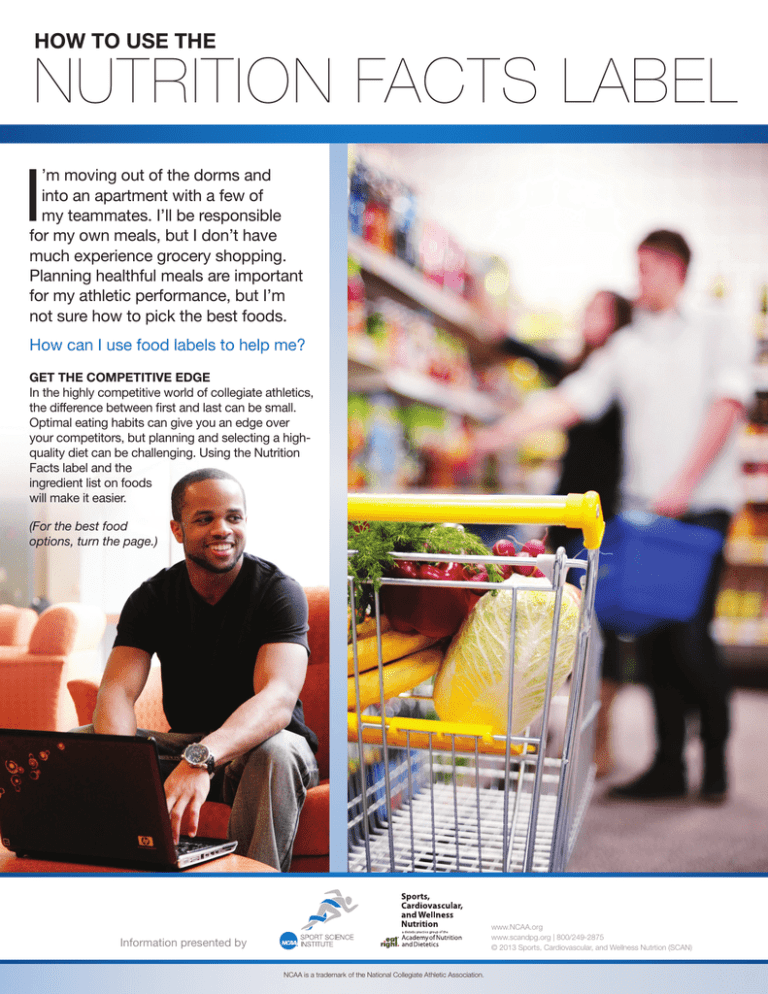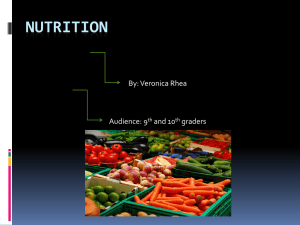I nutrition facts label How to use tHe
advertisement

How to use the nutrition facts label I ’m moving out of the dorms and into an apartment with a few of my teammates. I’ll be responsible for my own meals, but I don’t have much experience grocery shopping. Planning healthful meals are important for my athletic performance, but I’m not sure how to pick the best foods. How can I use food labels to help me? Get the competitive edge In the highly competitive world of collegiate athletics, the difference between first and last can be small. Optimal eating habits can give you an edge over your competitors, but planning and selecting a highquality diet can be challenging. Using the Nutrition Facts label and the ingredient list on foods will make it easier. (For the best food options, turn the page.) www.NCAA.org www.scandpg.org | 800/249-2875 © 2013 Sports, Cardiovascular, and Wellness Nutrtion (SCAN) Information presented by NCAA is a trademark of the National Collegiate Athletic Association. WHAT TO LOOK FOR: NUTRITION FACTS* 1 Calories multiplied by Servings Per Container equals Calories in one container. 2 Limit saturated and trans fat to make room for healthy fats (not always listed). 3 E valuate carbohydrate, protein and sodium based on your individual needs and training/competition phase. 4 Note % DV only for vitamins and minerals. H ere are tips to help you make healthful choices when selecting foods. Striving to meet all of these recommendations is optimal, but sometimes that’s not possible. Remember to focus on your total diet. Cereal, pasta, rice, granola bars, crackers, bread • Choose whole grain, such as whole wheat or whole rye, as the first or second food in the ingredient list, except right before or during exercise. • For women, select grain foods with more than 10% DV for iron. Salad dressings • Dressings can be a healthy source of fat in your diet. Lower-fat versions may not always healthier. • Simply use smaller portions. Beef, pork, chicken, fish • The Nutrition Facts label does not appear on fresh fish — it’s an allaround healthy choice! • Choose canned fish packed in water, rather than oil, for a great source of healthy fats. • Choose lean (less than 4.5 g per 3 ½-ounce serving) or extra lean cuts of meat (less than 2 g per serving) for nutrition without the saturated fat. Or, look for cuts with “loin” or “round” in the name. • Eat chicken without the skin. • Beef has the most iron of all meats (nearly 20% DV), especially important for women. 1 2 3 4 WHAT TO LOOK FOR: INGREDIENT LIST • Avoid stimulants, such as guarana, mate or caffeine. • If several servings are consumed per day, choose those with less than 20% DV for vitamins and minerals. • Avoid partially hydrogenated vegetable oils. *See related Fact Sheets to help determine your nutrition needs: Performance Hydration, Eating Before Exercise, Eating for Recovery, and Fueling During Exercise. Written by SCAN Registered Dietitians (RDs). For advice on customizing a nutrition plan, consult a RD who specializes in sports, particularly a Board Certified Specialist in Sports Dietetics (CSSD). Find a SCAN RD at www.scandpg.org. Frozen meals • Look for the correct balance of grains, vegetables and protein sources. Soups • Vegetable- and bean-based soups will help you increase vitamin, mineral and fiber intakes. Sauces (spaghetti, alfredo, salsa, nacho cheese) • Look for whole foods, such as tomatoes or milk, as the first two to three foods in the ingredient list. • Use smaller portions of high-fat sauces. Yogurt • Look for those with more than 20% DV for calcium. Spreads (cream cheese, nut butters, margarine/butter) • Use smaller portions. • Peanut and other nut butters are a good source of healthy fats and protein. Canned or frozen fruits and vegetables • Check the ingredient list to avoid added sugars, fats and sodium. Fruit juice, lemonade, tea, soft drinks, energy drinks • Choose “100%” juice. • Avoid drinks with more than 100% DV of vitamins or minerals. Sports/Energy/Protein Bars • Look for whole foods as the first two to three foods in the ingredient list. Other Snack Foods • Chips, crackers, puffs, sweets and similar snacks are best eaten in small amounts. • Baked snack varieties are generally lower in fat, but may be higher in added sugars and/or sodium.


